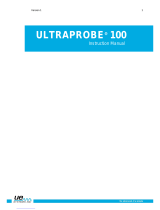
5
Tru Pointe® Ultra Instruction 0028-9000
Airborne Leak Detection
The Tru Pointe
®
Ultra is capable of detecting airborne leaks from up to 40 feet away. When an
ultrasonic signal generated from a leak is detected, it will be indicated by an increase in the LED
meter and a rushing sound will be heard in the headset. This sound will become more intense,
and the meter reading will increase as the instrument is drawn closer to the leak point.
The Tru Pointe
®
Ultra detects the ultrasound a gas makes as it leaks. Similar to the familiar hiss
a leak makes, a gas leak generates ultrasonic sound that humans cannot hear. This ultrasonic
sound propagates like a microwave (in straight lines) and this property makes it possible to fi nd
its source. It is a listening device not a Sniffer. Because of this, the Tru Pointe
®
Ultra can function
in areas where strong winds or a concentration of fumes are present.
A leak is any unwanted fl ow of a substance out of a system, or with vacuum, into a system. The
sound made by leaks (refrigerant, compressed air, tire leak etc.) is mostly ultrasonic and cannot
be heard by humans.
The following describes how to effectively determine the location of an airborne leak using the Tru
Pointe
®
Ultra.
1. Press the On/Off Button. If there is signifi cant background noise and the LED
Bargraph Display reads ‘10’, reduce the sensitivity until the LED’s disappear.
2. While pressing the On/Off Button, scan the area of the suspected leak in a side-to-
side motion.
3. While scanning, listen to differences in the sounds detected.
Mechanical Noise: Usually synchronized to machine
motion in the system and easy to identify
Leak Noise: A harsh hissing sound or bird song.
NOTE: To become familiar with the different sounds
detected by the Tru Pointe
®
Ultra, listen to the sound of
an air hose at low pressure or an aerosol cleaning spray,
then shake a set of keys. This demonstration allows the
user to distinguish between mechanical noise and leak
noise.
4. If there is leak noise in the area and the display is at ‘10’, slowly reduce the sensi-
tivity until the display reads ‘0’.
NOTE: The LED Bargraph Display is only for relative
measurements. If a scan of the system reveals an area
with a reading of ‘2’ and an area with a reading of ‘10’,
that can mean the detector is far from a leak, or there
are two leaks of differing sizes in the same area.
5. Approach the suspected leak. If the LED Bargraph Display reading increases,
reduce the sensitivity.
6. When the general location of the suspected leak is determined, adjust the sen-
sitivity to so that 4-5 lights are illuminated when the leak area is scanned. This
technique allows the user to accurately determine when the instrument is pointed
at an area of increased ultrasound. If the LED Bargraph display increases, then
the leak source is getting closer. If the display decreases, then the leak source is
getting further away.


















